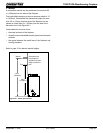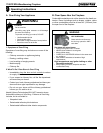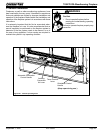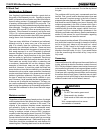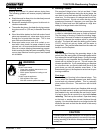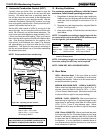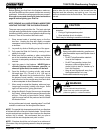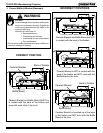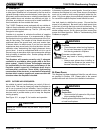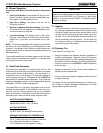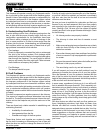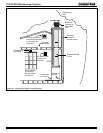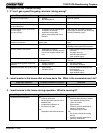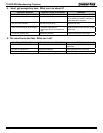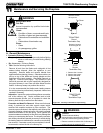
September 1, 2008
433-1390G
Page 51
7100FP EPA Woodburning Fireplace
R
K. Outside Air
A source of air (oxygen) is required in order for combustion
to take place. Whatever air is consumed by the fire must be
replaced through cracks around windows, under doors, etc.
Most newly constructed houses or existing homes fitted with
tightly sealed doors and windows are relatively air tight. In
this case, an outside air source must be made available to
feed combustion air from outside the home.
The 7100FP Fireplace comes equipped with an outside air
intake to feed combustion air from outside the home, along
with an outside air termination cap. The 6 in. (152 mm) solid/
flex pipe is not supplied.
Outside air is required to minimize the effects of negative
pressure within the structure. It is recommended to utilize
the shortest duct run to optimize the performance of the Out-
side Air flex tubing. The outside air inlet thimble should be
positioned above the ground level, and must remain clear
of leaves, debris, ice and/or snow. If you live in an area that
experiences deep snow levels, this must be taken into con-
sideration when determining the height placement above
ground level. It must be unrestricted while unit is in use to
prevent room air starvation which can cause smoke spillage
and an inability to maintain a fire. Smoke spillage can also
set off smoke alarms.
This fireplace will operate correctly only if adequate
ventilation is provided to allow proper draft to the fire-
place system. Hearth & Home Technologies assumes
no responsibility for the improper performance of the
fireplace system caused by inadequate draft due to
environmental conditions, down drafts, tight sealing
construction of the structure, or mechanical exhausting
devices which create a negative air pressure within the
structure where the fireplace is located.
NOTE: OUTSIDE AIR IS REQUIRED.
An outside air control handle allows you control of the out-
side air inlet. This may be closed only when the fireplace is
not in use to prevent cold air infiltration. Use of outside air
for combustion is required to conserve heated air within the
structure and to provide make up air to keep the fireplace
venting properly.
See Figure 15.1, on page 15, for location and operation.
L. Firescreen
A firescreen is optional to control sparks. It must be in place
whenever the fireplace is in use. Glass doors or firescreens
must not be used to hold burning material inside the fire-
place. Only those glass doors specifically tested and listed
for use with the specific fireplace model should be used.
Use both hands to stabilize the screen. Ensure that the
screen is fully attached. Be careful not to stack wood close
to the front or too high that logs could roll out the front. Start
with a small fire and adjust your heat to desired setting. If
smoke spillage occurs, put on gloves and then remove the
screen and close the doors. Refer to Troubleshooting
Draft
Problems on page 53.
M. Glass Doors
This fireplace has been tested and listed for use with doors
as specified in Section 12.E. Please refer to the manual
packed with each set of doors for installation instructions.
Fire Risk
Smoke Risk
• Doors must be fully opened or fully closed
when operating fireplace.
Partially opened doors may draw flame, smoke
or heat from fireplace.
WARNING
CAUTION
Outside air control handle may be warm. Adjust before
lighting fire.
Fire Risk
• Close firescreen when burning fireplace.
• Do not use firescreen or glass doors to
hold burning material in fireplace.
Firescreen controls sparks.
Glass may break or burning material may
roll out.
•
Always wear gloves when installing or
removing the screen as the screen may
become extremely hot while in use.
WARNING



